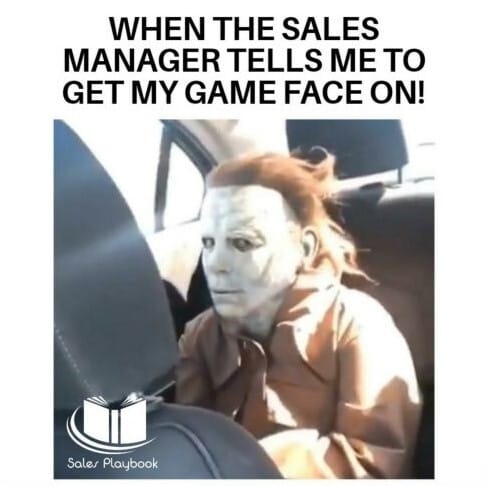- SalesDaily for Leaders
- Posts
- 🏗️ coach your reps better
🏗️ coach your reps better
Discover why most sales teams fail after training
Welcome to SalesDaily for Leaders: your weekly briefing packed with actionable insights to help you manage better, coach smarter, and drive results in B2B sales.
Every Sunday, we provide the latest strategies, resources, and ideas for leading high-performing teams and staying ahead in today’s competitive landscape.
Let’s dive in!
In today’s issue:
James Bissell: Treat recruiters as partners, not vendors
Krysten Conner: Protect yourself during forecast season
Matt Green: Training your sellers for executive presence
David Weiss: Building clarity through leadership rhythm
Tyler Phillips: Learn when to use ML, prompts, or agents
👉 SalesDaily Elite - Power up your sales team
If you lead a sales team, run training sessions, or coach reps - this is for you.
With SalesDaily Elite, you get full white-label rights to my complete library of sales cheat sheets, guides, and templates.
✔️ Editable Canva files you can brand as your own
✔️ Ready-to-use for team onboarding, and workshops
✔️ Built for high-impact sales team enablement
Stop wasting time building resources from scratch.
Treat recruiters as partners, not vendors
James Bissell breaks down how to make GTM recruitment faster and more effective.
The market has shifted
🎤 The best candidates move on while companies delay.
🎤 More applicants doesn’t mean more qualified people.
➤ Treat hiring urgency like sales urgency — time kills deals.
Example: A SaaS company waited three weeks to decide on a top AE candidate. He accepted another offer within days. The role stayed open for two months.
Recruiters as partners
🎤 Good recruiters don’t just pass you CVs.
🎤 They run discovery and share market data.
➤ They shorten cycles by protecting your brand.
➤ They help you hire smarter and filter bad choices.
Example: A recruiter asked a CRO to clarify whether “hunter” meant pure outbound or expansion sales. That question changed the job spec and improved candidate fit instantly.
Hire like you’re selling
🎤 Think of interviews as two-way sales calls.
➤ Sell the opportunity, not the job description.
➤ Build a business case that makes “yes” easy.
➤ Watch how great candidates qualify and pitch.
Example: A manager framed the role as “owning a $2M territory with freedom to shape strategy,” not just “hitting quota.” The right candidate lit up.
Employer brand as a magnet
🎤 Your online presence decides who applies.
🎤 Show culture, growth, and people thriving.
➤ A players won’t just apply for B brands.
➤ Visibility and authenticity attract talent.
Example: A company posted team wins, promotion stories, and customer success moments weekly. Their inbound candidate quality doubled in three months.
Set expectations beforehand
🎤 Before day one, define long-term goals:
➤ “What I expect from you?” → “What you can expect from me”
🎤 Review it in 1:1s to keep goal alignment.
Example: In onboarding, a VP of Sales lists expectations like “own your pipeline hygiene” and “expect weekly coaching feedback.” The rep does the same. Both revisit it monthly.
Data beats your gut feeling
🎤 Use scorecard metrics to track SDR’s results:
➤ Scores vs. performance
➤ Ramp time vs. plan
➤ Reasons for attrition
🎤 Transform hiring into a repeatable process.
Example: After tracking six hires, one startup learned candidates who scored high on “coachability” ramped 40% faster than those who didn’t.
The culture truth test
🎤 Be upfront about what working at your company is like.
🎤 Honesty attracts those people built for your environment.
Example: A founder tells candidates, “We’re still building structure. You’ll need to thrive in ambiguity.” It scares some, but the ones who stay succeed.
Protect yourself during forecast season
Krysten Conner explains the hidden politics of pipeline management.
Know exactly what to do and protect your customer relationships.
1. Creating your pipeline
Every company defines pipeline differently.
➔ Some count early “Aspirational” deals. Others require strict qualification.
AE vs SDR ownership: If leadership tracks AE-sourced pipeline, AEs may feel pressure to claim opportunities. This can strain relationships with SDRs.
CYA piping: Managers sometimes ask reps to log weak deals “for coverage.” It might look safe short term but hurts long-term credibility afterwards.
✔ Example: At Salesforce, “Stage 0” pipeline helped execs plan resources. At smaller orgs, that same deal might be seen as nonsense. Confirm your org’s rulebook.
➔ Politics start when leaders care who sourced the pipe and how it looks on paper.
2. Moving deals through
➔ Healthy pipelines show velocity. But speed can be political, too.
Managers are judged on how fast deals move, and possibly stall.
✔ Example: If a six-figure deal sits in Stage 2 for 60 days, expect questions from every direction. Even if the buyer’s timing is normal, you’ll be expected to explain the holdup.
➔ Keep your CRM safe with context notes like “Budget cycle closes Q1.”
This response protects you from “why is this stuck?” conversations later.
3. Taking your deals out
➔ Closing out bad deals builds trust — but it can create tension.
Some managers prefer to keep dead deals alive for “coverage.”
✔ Example: You might know a deal is lost, but your manager keeps it in this quarter’s forecast. Removing it makes their report look thin. Leaving it risks your accuracy score.
➔ Gauge how much political capital you have.
In strong relationships, you can push back.
In weak ones, it might be safer to align first.
How to navigate this:
➔Ask these questions directly:
“Different leaders view pipeline differently. I want to make sure we’re aligned — when should I enter, move, or remove Opps?”
✔ Example: One AE who clarified definitions in week one avoided getting flagged for “low pipe creation” later because her manager knew exactly what counted.
➔ This portrays maturity and saves confusion later.
➔ Knowing the rules helps you play the game better.
Newsletters loved by SalesDaily readers:
The Neuron: Make AI work for you
Big Desk Energy: Startup stories and lessons
B2B Whales: Proven B2B sales strategies
The Rundown AI: Join 1M+ readers getting the latest AI news
The Growth Newsletter: Tactics used by fast-growing startups
Check them out!
Training your sellers for executive presence
Matt Green reveals how when your close rates are up, net pipelines get steady.
1. Define what “qualified” means
📌 Stop using qualification frameworks from 2019.
📌 Booked meetings imply research and shortlists.
💬 Expect prospects to have:
Researched your products
Checked budget alignment
Narrowed the playing field
Example: A buyer who schedules a call after viewing your pricing page and customer case studies has likely done 70% of qualification themselves.
2. Shift your headcount model
📌 Fewer, better AEs can produce the same output as larger, volume-focused teams.
💬 Example math:
Ten AEs × 100 opps × 20% = 200 deals
versus
Seven AEs × 80 opps × 35% ≈ 196 deals
📌 Result: Lower headcount cost and higher ACVs when you develop senior reps.
Example: A startup cut its AE team by 30%, invested in advanced training for the remaining reps, and saw win rates rise from 18% to 33% in two quarters.
3. Change productivity measures
📌 Stop rewarding volume metrics only.
📌 Track SDRs’ speed and quality instead.
💬 Begin tracking your:
Time from first call to close
Demo advancement rates (80%+)
Multi-threading deal velocity
❌ Stop tracking: Calls per day, Emails sent, Activities logged.
Example: One company replaced “50 calls per day” goals with “reduce sales cycle from 45 to 30 days.” Reps focused on qualified deals and improved efficiency.
4. Rewrite your comp blueprint
📌 Design pay to reward customer success, not just activity.
💬 Try logging in:
Base commissions on closed revenue
Velocity bonus if deal closes under [X] days
Quality bonus if customer hits milestones
📌 This aligns rep behavior with speed and deal quality.
Example: A cybersecurity firm added a 3% bonus for deals closed under 40 days. Within one quarter, cycle time dropped by 25% without lowering deal size.
5. Train sellers differently
📌 Focus on skills buyers now require after doing research.
💬 Teach your sellers:
Advanced storytelling
Business case co-creation
Political navigation
📌 Move away from BANT-style training and into exec presence.
Example: Instead of teaching how to qualify budget, train reps to build internal champions with a 3-slide ROI story tailored to CFO priorities.
Building clarity through leadership rhythm
David Weiss discusses how results come from how leaders use MEDDICC in the field.
1. Sales activation
🔑 Each letter (Metrics, Economic Buyer, Decision Criteria, etc.) needs a customized definition for your business.
Ask these questions:
• What does each letter mean for us?
• How do we capture and visualize it?
• When should MEDDICC be solidified?
• What’s our plan when it’s missing?
Example: At one SaaS firm, “Metrics” was redefined as “agreed business outcomes”. Reps visualized these in discovery instead of burying notes — increasing exec engagement.
🔑 Align it by stage — not as exit criteria, but as building blocks.
🔑 By Stage 3, pain should evolve from identified to implicated.
2. Leadership activation
🔑 If leaders don’t embed MEDDICC into their rhythm, credibility dies instantly.
🔑 QBRs, deal reviews, and 1:1s should reflect MEDDICC thinking every time.
Ask yourself:
• Are deals color-coded or risk-scored by MEDDICC completeness?
• Are EBs, champions, and decision processes validated weekly?
• Are leaders challenging “green” deals before approving forecasts?
Example: A VP of Sales began forecast sessions where deals are scored red/yellow/green against MEDDICC. Within one quarter, forecast accuracy improved by 20%.
🔑 When leaders skip reinforcing, this sales framework becomes just noise.
TO-GO
Tyler Phillips: Learn when to use ML, prompts, or agents
Matt Green: How to future-proof your entire sales team
Kevin Dorsey: Broad sales advice creates mediocre reps
Todd Busler: Improve teams with faster coaching speed
Jeff Ignacio: Eliminate messy data from contract reviews
QUOTE OF THE DAY
"Successful sales managers don’t win on their own - they win through their people by helping them succeed."
PODCASTS
HUMOR




